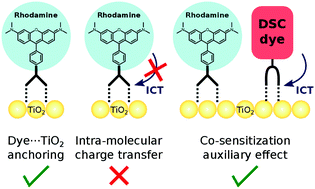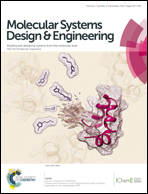Rationalizing the suitability of rhodamines as chromophores in dye-sensitized solar cells: a systematic molecular design study†
Abstract
Rhodamines are chromophores that are employed in many dye applications. Their strong optical absorption in the visible region of the electromagnetic spectrum renders them attractive dye candidates for dye-sensitized solar cells (DSCs). However, they have not yet been systematically tested in DSCs as single- or co-sensitizers. Recent advances in concerted experimental and computational workflows involving molecular design protocols can afford a better understanding of the molecular origins of the optoelectronic properties in these sensitizers. Herein, we examine the suitability of rhodamines R560 (1), R575 (2), R590 (3), R610 (4), R620 (5), R640 (6), and R3B (7) as chromophores in co-sensitized DSCs. Our study follows a stepwise approach. Initially, structural and optical properties of the dyes are investigated by experimental and computational methods to reveal structure–property relationships and other useful features for DSC applications. Subsequently, 1–7 are investigated at the dye⋯TiO2 interface, both by calculations of dye-adsorption onto the surface of a modeled (TiO2)9 cluster, and by experimental studies of dye-adsorption on TiO2. For that purpose, a selection of rhodamine dyes are paired together, (1 and 5) and (1 and 7), for co-sensitization, among which 5 is also co-adsorbed with a fluorescein dye in order to explore chemical compatibility factors. The best dye candidates are identified from the findings of these adsorption studies in terms of dye aggregation, anchoring modes, and panchromatic response. Despite their promising dye⋯TiO2 adsorption and optical prospects, our results show that rhodamines lack a suitable intramolecular charge transfer pathway for dye-to-TiO2 electron injection to occur, thus precluding their photovoltaic function as DSC dyes. Our results are then assessed against ostensibly disparate reports of rhodamines performing successfully in DSC devices; this comparison necessitated the internal reproduction of previously reported co-sensitization experiments on 2 with the industrial standard reference dye, N3. We achieve reconciliation between our results and those in the literature by reasoning that while rhodamines cannot deliver photovoltaic function in DSCs in their own right, they can either act to facilitate or deplete the photovoltaic output of a DSC indirectly by affecting the TiO2 adsorption prospects of a photovoltaic-active dye with which a rhodamine is co-sensitized.


 Please wait while we load your content...
Please wait while we load your content...